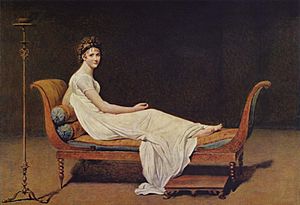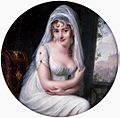Juliette Récamier facts for kids
Quick facts for kids
Juliette Récamier
|
|
|---|---|
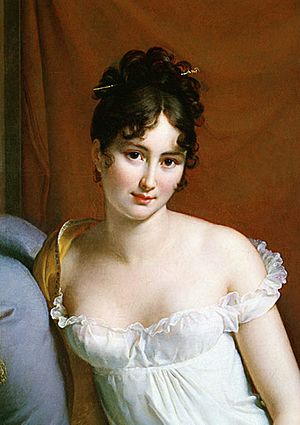
Portrait by François Gérard, 1805 (detail), Paris, Carnavalet Museum
|
|
| Born | 3 December 1777 |
| Died | 11 May 1849 (aged 71) Paris, France
|
| Occupation | Salonnière |
| Spouse(s) |
Jacques-Rose Récamier
(m. 1793; died 1830) |
Juliette Récamier (born Jeanne Françoise Julie Adélaïde Récamier; 3 December 1777 – 11 May 1849) was a very famous French socialite. She was known for her special gatherings called "salons" in Paris. These salons brought together important writers, artists, and political leaders in the early 1800s.
Juliette was seen as a symbol of neoclassicism, a popular style at the time. She was known for her great beauty, and her fame spread all over Europe. She became friends with many smart people, posed for famous artists, and even turned down a marriage proposal from Prince Augustus of Prussia.
Contents
Juliette's Early Life and Family
Juliette Récamier was born in Lyon, France. She was the only child of Jean Bernard, who was a notary and a King's counsellor, and his wife, Julie Matton.
In 1784, her father got a new job as a finance receiver. Juliette briefly went to school at the Couvent de la Déserte in Lyon. Later, her family moved to Paris. The name "Juliette" is a shorter, more loving version of "Julie." People described Juliette as beautiful, talented, and a lover of books. She was also known for being shy and modest.
Juliette's Marriage and Social Influence
When she was fifteen, Juliette married Jacques-Rose Récamier on April 24, 1793. He was a banker and almost thirty years older than her. Their marriage happened during a very difficult time in France, known as the French Revolution's "Reign of Terror."
There was a rumor that her husband was actually her father. Some people thought he married her so she would inherit his money if he was executed during the revolution. However, this rumor has never been proven and many historians do not believe it.
Juliette Récamier was very charming. She had strong emotional friendships with many people, including the famous writer François-René de Chateaubriand. He was a frequent guest at her salon and was almost like the master of her house.
A European Celebrity and Her Salon
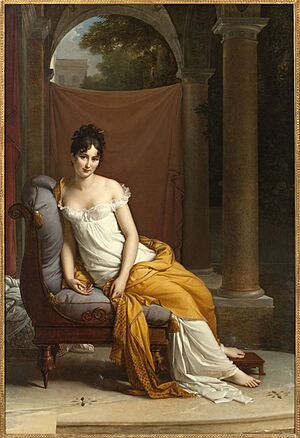
From the early 1800s, Juliette Récamier's salon in Paris became a very important place for literary and political discussions. Many people who visited her home were former royalists, who supported the old kings. Others, like General Jean Bernadotte and General Jean Victor Moreau, were not happy with the government at the time.
Because of these connections, and because she refused to work for Empress Joséphine de Beauharnais (Napoleon's wife), Juliette came under suspicion. Her friendship with Germaine de Staël, another influential woman, also caused problems.
In 1800, the famous artist Jacques-Louis David started painting her portrait. But he stopped when he found out that François Gérard had already been asked to paint her.
Through Germaine de Staël, Juliette met Benjamin Constant, a Swiss-French writer and political activist. Juliette's influence was thought to be behind some of his political choices. Eventually, Napoleon ordered Juliette to leave Paris. She stayed for a short time in her hometown of Lyon, then went to Rome, and finally to Naples. There, she became good friends with Joachim Murat and his wife Caroline Bonaparte.
Juliette's Later Years
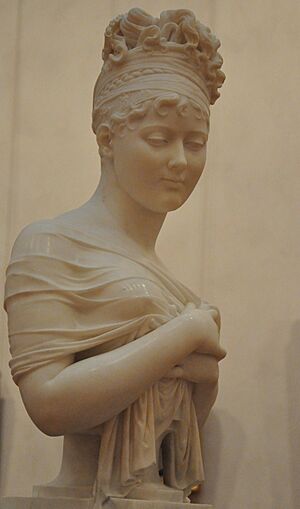
In 1805, Juliette's husband lost a lot of money. She visited Germaine de Staël in Switzerland. There was a plan for Juliette to divorce her husband so she could marry Prince Augustus of Prussia. Her husband was willing, but the marriage did not happen.
In her later years, Juliette lost most of her remaining money. But she continued to welcome visitors in her apartment at Abbaye-aux-Bois. This was a 17th-century convent in Paris where she lived from 1819.
Even as she grew older and faced health problems, including partial blindness, Juliette never lost her charm. She had many admirers, including Mathieu de Montmorency, Lucien Bonaparte, and Benjamin Constant. However, no one influenced her as much as François-René de Chateaubriand, even though he could be difficult.
In 1849, Juliette Récamier passed away in Paris from cholera. She was 71 years old. She was buried in the Cimetière de Montmartre in Montmartre, which was a village north of Paris at the time.
Juliette Récamier's Cultural Legacy
A special type of sofa or chaise longue, which she loved to recline on, was named the récamier after her.
She was also the subject of two silent films. One was a German film from 1920 called Madame Récamier. The other was a French film from 1928, also called Madame Récamier.
In October 2015, a French award was created in her honor. It is called the prix Récamier (Récamier Prize) and it celebrates French-speaking novels.
Gallery
-
Portrait by François Gérard (1805)
-
Portrait of Madame Récamier by Antoine-Jean Gros (1825)
-
Crayon noir by François Gérard (1829)
See also
 In Spanish: Juliette Récamier para niños
In Spanish: Juliette Récamier para niños
- Jean Anthelme Brillat-Savarin
- Germaine de Stael
- Francois-Rene de Chateaubriand
- Jacques-Louis David
- Francois, Baron Gerard
- Jacques-Rose Recamier
- Prince Augustus of Prussia


